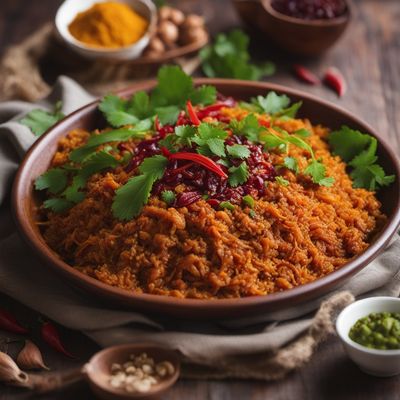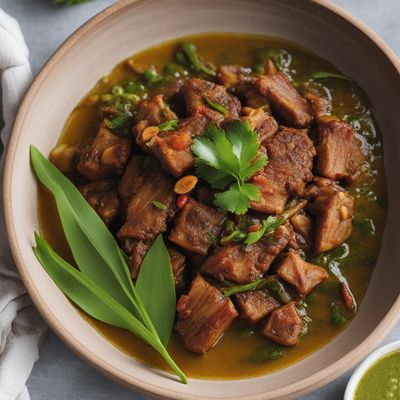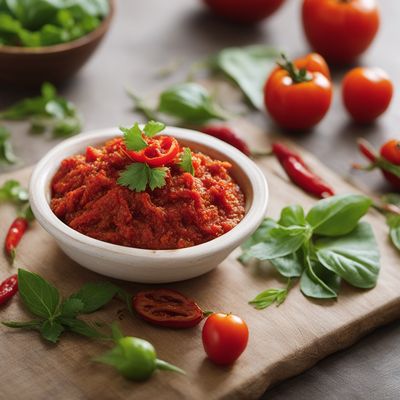
Ingredient
Candlenut seeds
The Versatile Candlenut: A Culinary Gem
Candlenut seeds are small, round nuts with a hard shell and a soft, oily interior. They have a distinct flavor that is often described as nutty, buttery, and slightly sweet. When roasted or toasted, candlenut seeds develop a rich aroma and a crunchy texture. They are commonly ground into a paste or used as a thickening agent in sauces, curries, and marinades. In addition to their culinary uses, candlenut seeds are also valued for their oil, which is used in traditional medicine and skincare products.
Origins and history
Candlenut seeds have a long history in Southeast Asian cuisines, particularly in Indonesia, Malaysia, and Singapore. They are a staple ingredient in dishes like rendang, a rich and flavorful meat stew, and sambal, a spicy chili sauce. In these regions, candlenut seeds are highly regarded for their unique taste and are often considered essential for achieving authentic flavors. Culturally, candlenut seeds have been used in traditional medicine for their potential health benefits, such as reducing inflammation and promoting hair growth.
Nutritional information
Candlenut seeds are a good source of healthy fats, protein, and fiber. They also contain essential minerals like calcium, iron, and magnesium. However, they are high in calories, so it is important to consume them in moderation. Additionally, individuals with nut allergies should exercise caution when consuming candlenut seeds.
Allergens
May contain allergens such as nuts. Individuals with nut allergies should avoid consuming candlenut seeds or products containing them.
How to select
When selecting candlenut seeds, look for ones that are plump, firm, and free from cracks or mold. Avoid seeds that appear shriveled or discolored, as they may be stale or rancid. If possible, choose whole candlenut seeds instead of pre-ground ones to ensure freshness and quality.
Storage recommendations
To maintain the freshness of candlenut seeds, store them in an airtight container in a cool, dry place away from direct sunlight. Alternatively, refrigerate or freeze them to extend their shelf life. Ground candlenut seeds should be stored in a sealed container in the refrigerator to prevent rancidity.
How to produce
Candlenut trees can be grown in tropical or subtropical regions with well-drained soil and ample sunlight. They require regular watering and protection from strong winds. However, growing candlenut trees from seeds can be challenging, so it is recommended to obtain young saplings from nurseries or specialized suppliers.
Preparation tips
Before using candlenut seeds in recipes, they need to be prepared by roasting or toasting to enhance their flavor and remove any bitterness. To do this, place the seeds in a dry pan over medium heat and stir frequently until they turn golden brown and become fragrant. Allow them to cool before grinding or using in recipes. Candlenut seeds are commonly used in Indonesian and Malaysian dishes, such as rendang, satay sauce, and laksa. They can also be added to stir-fries, curries, or used as a thickening agent in sauces.
Substitutions
Macadamia nuts or almonds can be used as substitutes for candlenut seeds. While they may not provide the exact same flavor profile, they offer a similar creamy texture and nuttiness that can complement various dishes.
Culinary uses
Candlenut seeds are widely used in Southeast Asian cuisines, particularly in Indonesian, Malaysian, and Singaporean dishes. They are commonly ground into a paste and used as a base for sauces, curries, and marinades. Candlenut seeds are also added to traditional dishes like nasi lemak, a fragrant coconut rice dish, and babi guling, a Balinese roasted pork dish. Additionally, they can be incorporated into desserts, such as cakes or cookies, to add a unique twist.
Availability
Candlenut seeds are primarily cultivated in Southeast Asian countries, including Indonesia, Malaysia, and the Philippines. They are also found in other tropical regions with suitable growing conditions. However, they can be challenging to find in some Western countries, where they may be available in specialty Asian grocery stores or online.
More ingredients from this category
Recipes using Candlenut seeds

Peranakan-style Masna Pogača
Nyonya Twist: Peranakan-style Masna Pogača

Betawi-style Blodpalt
Savory Betawi Blood Dumplings: A Unique Twist on Traditional Swedish Cuisine

Peranakan-style Coconut Heart of Banana Blossom Curry
Nyonya Delight: Fragrant Coconut Curry with Banana Blossom Hearts

Madurese Shrimp Rice
Savory Delight: Madurese Shrimp Rice - A Fusion of Flavors

Madurese-style Mumu
Savory Banana Leaf-Wrapped Delight: Madurese-style Mumu

Betawi-style Fasulye Pilaki
Betawi Delight: Flavorful Fasulye Pilaki

Sundanese-inspired Fresh Tomato Sambal
Sundanese Spice Infusion: Fresh Tomato Sambal

Betawi-style Chireta
Betawi Delight: A Flavorful Twist on Chireta